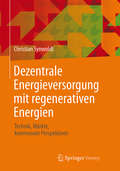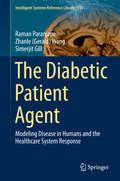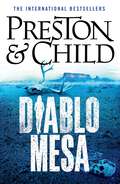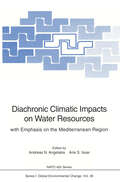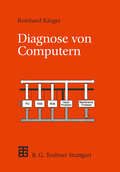- Table View
- List View
Dezentrale Energieversorgung mit regenerativen Energien: Technik, Märkte, kommunale Perspektiven
by Christian SynwoldtDas vorliegende Buch bietet eine Übersicht und Einführung in die Verfahren regenerativer Energiegewinnung sowie deren technische Grundlagen. Es ist als Lehrbuch konzipiert und kann auch als Handbuch und Nachschlagewerk eingesetzt werden. Darüber hinaus sind Verfahren berücksichtigt, die in Europa nicht gängig sind, wie z. B. Aufwindkraftwerk oder Solarteich. Damit ist es für internationale Projekte und im Umfeld technischer Zusammenarbeit einsetzbar. Außerdem sind Konzepte zur Entwicklung des Ländlichen Raums sowie Finanzierungs- und Marktmodelle besprochen.Durch zahlreiche Backgroundinformationen („Abflussgrößen in der Hydrologie“ oder „Weltweiter Kostenvergleich von Photovoltaikanlagen“) kann das Grundlagenwissen eigenständig erweitert werden und das Buch je nach Studienphase zur Intensivierung und Wiederholung der Lerninhalte immer wieder herangezogen werden. Berechnungen sind an konkreten Fragestellungen durchgeführt. Auf diese Weise regt der Autor an, das angeeignete Wissen zur kritischen Einschätzung von Sachverhalten zu verwenden.
Dezentrale Energieversorgung mit regenerativen Energien: Technik, Märkte, kommunale Perspektiven
by Christian SynwoldtDas vorliegende Buch bietet eine Übersicht und Einführung in die Verfahren regenerativer Energiegewinnung sowie deren technische Grundlagen. Es ist als Lehrbuch konzipiert und kann auch als Handbuch und Nachschlagewerk eingesetzt werden. Ferner sind Verfahren berücksichtigt, die in Europa nicht gängig sind, wie z. B. Aufwindkraftwerk oder Solarteich. Damit ist es für internationale Projekte und im Umfeld technischer Zusammenarbeit einsetzbar. Neben der intensiven Auseinandersetzung mit technologischen Aspekten steht die systemische Betrachtung der Energieversorgung im Mittelpunkt. Außerdem sind Konzepte zur Entwicklung des ländlichen Raums sowie Finanzierungs- und Marktmodelle besprochen.Durch zahlreiche Backgroundinformationen („Abflussgrößen in der Hydrologie“ oder „Weltweiter Kostenvergleich von Photovoltaikanlagen“) kann das Grundlagenwissen eigenständig erweitert werden und das Buch je nach Studienphase zur Intensivierung und Wiederholung der Lerninhalte immer wieder herangezogen werden. Berechnungen sind an konkreten Fragestellungen durchgeführt. Auf diese Weise regt der Autor an, das angeeignete Wissen zur kritischen Einschätzung von Sachverhalten zu verwenden.
Dezentrale Energiewende: Chancen und Herausforderungen
by Jürgen EiseltDieses Buch ist eine umfassende Bestandsaufnahme für eine bereits angelaufene dezentrale Energiewende. Anhand vorhandener Strukturen, Techniken und wissenschaftlich fundierten Erkenntnissen werden die Potentiale einer wirkungsvollen Energiewende beschrieben. Ziel dieses Buches ist die Darstellung neuer Techniken und efferktiver Konzepte, damit dezentrale Strukturen die zentrale Energieversorgung ablösen. Hauptantrieb für den Einsatz der dezentralen Energieformen sind Kostenreduzierung, energieautarke Systeme bis zur Null-Tarif-Heizung.
Dezentrales vernetztes Energiemanagement: Ein Ansatz auf Basis eines verteilten adaptiven Realzeit-Multiagentensystems
by Sebastian LehnhoffSebastian Lehnhoff entwickelt ein Energiemanagementsystem für dezentrale und vorrangig regenerative Energieumwandlungsanlagen unter verteilter Kontrolle, das den Reserveleistungsbedarf reduziert und vorhandene Effizienzpotenziale stärker nutzt.
DFT - Diskrete Fourier-Transformation: Elementare Einführung
by André NeubauerDie diskrete Fourier-Transformation DFT stellt eines der wichtigsten Werkzeuge der digitalen Signalverarbeitung und der Signaltheorie dar. Sie besitzt eine Vielzahl von Anwendungen wie beispielsweise in der Informations- und Kommunikationstechnik, in der technischen Informatik, in der Messtechnik und in der Medizintechnik. Das Lehrbuch bietet eine leicht verständliche elementare Einführung in die Grundlagen der DFT. Neben den Eigenschaften und Korrespondenzen der DFT werden ihre effiziente Implementierung mit Hilfe der schnellen Fourier-Transformation FFT erläutert sowie als wichtiges Anwendungsbeispiel die schnelle Faltung behandelt. Sämtliche im Buch für die Behandlung der DFT benötigten mathematischen Grundlagen werden beschrieben und erleichtern somit sowohl Studierenden als auch Schülern den Zugang zu diesem für praktische Anwendungen wichtigen und interessanten Themenfeld. Aufgrund der eingefügten Beispiele sowie der detaillierten Herleitungen ist das Buch sowohl vorlesungsbegleitend als auch zum Selbststudium hervorragend geeignet.
DFT-Domain Based Single-Microphone Noise Reduction for Speech Enhancement (Synthesis Lectures on Speech and Audio Processing)
by Richard C. Hendriks Timo Gerkmann Jesper JensenAs speech processing devices like mobile phones, voice controlled devices, and hearing aids have increased in popularity, people expect them to work anywhere and at any time without user intervention. However, the presence of acoustical disturbances limits the use of these applications, degrades their performance, or causes the user difficulties in understanding the conversation or appreciating the device. A common way to reduce the effects of such disturbances is through the use of single-microphone noise reduction algorithms for speech enhancement. The field of single-microphone noise reduction for speech enhancement comprises a history of more than 30 years of research. In this survey, we wish to demonstrate the significant advances that have been made during the last decade in the field of discrete Fourier transform domain-based single-channel noise reduction for speech enhancement.Furthermore, our goal is to provide a concise description of a state-of-the-art speech enhancement system, and demonstrate the relative importance of the various building blocks of such a system. This allows the non-expert DSP practitioner to judge the relevance of each building block and to implement a close-to-optimal enhancement system for the particular application at hand. Table of Contents: Introduction / Single Channel Speech Enhancement: General Principles / DFT-Based Speech Enhancement Methods: Signal Model and Notation / Speech DFT Estimators / Speech Presence Probability Estimation / Noise PSD Estimation / Speech PSD Estimation / Performance Evaluation Methods / Simulation Experiments with Single-Channel Enhancement Systems / Future Directions
DGOR: Papers of the 20th Annual Meeting / Vorträge der 20. Jahrestagung (Operations Research Proceedings #1991)
by Wolfgang W. Stahl Wolfgang A. Gaul Achim Bachem Walter Habenicht Walter RungeDGOR/NSOR: Papers of the 16th Annual Meeting of DGOR in Cooperation with NSOR/Vorträge der 16. Jahrestagung der DGOR zusammen mit der NSOR (Operations Research Proceedings #1987)
by Helmut Schellhaas Paul Van Beek Heinz Isermann Reinhart Schmidt Mynt ZijlstraDGOR / ÖGOR: Papers of the 21th Annual Meeting of DGOR in Cooperation with ÖGOR Vorträge der 21. Jahrestagung der DGOR zusammen mit ÖGOR (Operations Research Proceedings #1992)
by Karl-Werner Hansmann Achim Bachem Matthias Jarke Wolfgang E. Katzenberger Alfred MarusevDhaka Megacity: Geospatial Perspectives on Urbanisation, Environment and Health (Springer Geography)
by Ashraf Dewan Robert CornerThe book Dhaka Megacity: Geospatial Perspectives on Urbanisation, Environment and Health presents the use of geospatial techniques to address a number of environmental issues, including land use change, climatic variability, urban sprawl, population density modelling, flooding, environmental health, water quality, energy resources, urban growth modelling, infectious diseases and the quality of life. Although the work is focused on the Megacity of Dhaka in Bangladesh, the techniques and methods that are used to research these issues can be utilized in any other areas where rapid population growth coupled with unplanned urbanization is leading to environmental degradation. The book is useful for people working in the area of Geospatial Science, Urban Geography, Environmental Management and International Development. Since the chapters in the book cover a range of environmental issues, this book describes useful tools for assisting informed decision making, particularly in developing countries.
The Diabetic Patient Agent: Modeling Disease in Humans and the Healthcare System Response (Intelligent Systems Reference Library #133)
by Raman Paranjape Zhanle Gerald Wang Simerjit GillThis book provides a pioneering approach to modeling the human diabetic patient using a software agent. It is based on two MASc (Master of Applied Science) theses: one looking at the evolution of the patient agent in time, and another looking the interaction of the patient agent with the healthcare system. It shows that the software agent evolves in a manner analogous to the human patient and exhibits typical attributes of the illness such as reacting to food consumption, medications, and activity. This agent model can be used in a number of different ways, including as a prototype for a specific human patient with the purpose of helping to identify when that patient’s condition deviates from normal variations. The software agent can also be used to study the interaction between the human patient and the health care system. This book is of interest to anyone involved in the management of diabetic patients or in societal research into the management of diabetes. The diabetic patient agent was developed using the Ackerman model for diabetes, but this model can be easily adapted for any other model subject with the necessary physiological data to support that model.
Diablo Mesa (Nora Kelly)
by Douglas Preston Lincoln ChildFan favourites Nora Kelly and Corrie Swanson return in the new thriller from international bestsellers Preston & Child. Forced to leave her post at the Santa Fe Archaeological Institute, Nora Kelly is left without a job and without any prospects. So when billionaire Lucas Tappan invites her to lead his excavation of the infamous Roswell landing site, she has no choice but to make a decision that could destroy her reputation.Armed with a healthy dose of scepticism, Nora reluctantly agrees to visit. When the preliminary scans of the area reveal a suspected Native American burial site, Nora takes a closer look.But this is no indigenous burial site. It's a crime scene, and a recent one at that. Nora uncovers two dead bodies, one with a bullet hole in its skull, acid used to conceal the identities. Dead bodies mean this has become a case for the FBI, and Nora knows just the person to investigate – Special Agent Corrie Swanson.As Corrie and Nora dig deeper into the mystery, they will uncover more questions than answers. And the truth they seek will be even stranger than the conspiracy it hides behind...'Down-to-earth action tackles an otherworldly mystery in this devilishly plausible yarn' KIRKUS starred review
Diachronic Climatic Impacts on Water Resources: with Emphasis on the Mediterranean Region (Nato ASI Subseries I: #36)
by Andreas N. Angelakis and Arie S. IssarSince the beginning of man's existence on Earth, the adequacy of available water has been as important as any other factor for man's survival and prosperity. The volume comprises comprehensive reviews on: Paleoenvironments of arid land, climate-water-man interactions, water resources in the Minoan era, ancient Greek examples of avoiding water shortages, climatic changes in the eastern Mediterranean region since 5000 B.C., climatic evolution in ancient civilizations based on fossil studies, impact of climatic changes on groundwater and Mediterranean wetlands. The book is written for civil and agricultural engineers, hydrologists, geologists, environmental scientists and researchers. It is also useful as a reference to consulting engineers, agriculturists, environmentalists and students.
Diachronic Perspectives on Embodiment and Technology: Gestures and Artefacts (Philosophy of Engineering and Technology #46)
by Thiemo Breyer Alexander Matthias Gerner Niklas Grouls Johannes F. M. SchickThis book investigates the relationships between gestures and artefacts theoretically and historically, by analyzing different phenomena stemming from a variety of fields such as robotics, archaeology, gesture studies, anthropology, philosophy, and gestural practices like choreography, music performance, and composition. It underlines how embodiment and technology change the interplay between maker and artefact over time and appeals to students and researchers in these fields. Its goal is to enable the reader to understand that the recurring topics and questions as well as multi-level similarities are by no means accidental, but can best be understood if one pays attention to the intertwinements of materiality and cognition, praxis and techne.
Diagnosability, Security and Safety of Hybrid Dynamic and Cyber-Physical Systems
by Moamar Sayed-MouchawehCyber-physical systems (CPS) are characterized as a combination of physical (physical plant, process, network) and cyber (software, algorithm, computation) components whose operations are monitored, controlled, coordinated, and integrated by a computing and communicating core. The interaction between both physical and cyber components requires tools allowing analyzing and modeling both the discrete and continuous dynamics. Therefore, many CPS can be modeled as hybrid dynamic systems in order to take into account both discrete and continuous behaviors as well as the interactions between them. Guaranteeing the security and safety of CPS is a challenging task because of the inherent interconnected and heterogeneous combination of behaviors (cyber/physical, discrete/continuous) in these systems. This book presents recent and advanced approaches and tech-niques that address the complex problem of analyzing the diagnosability property of cyber physical systems and ensuring their security and safety against faults and attacks. The CPS are modeled as hybrid dynamic systems using different model-based and data-driven approaches in different application domains (electric transmission networks, wireless communication networks, intrusions in industrial control systems, intrusions in production systems, wind farms etc.). These approaches handle the problem of ensuring the security of CPS in presence of attacks and verifying their diagnosability in presence of different kinds of uncertainty (uncertainty related to the event occurrences, to their order of occurrence, to their value etc.).
Diagnose steuerungsexterner Fehler an Fertigungseinrichtungen (ISW Forschung und Praxis #48)
by J. SchwagerDiagnosesystem für steuerungsperiphere Fehler an Fertigungseinrichtungen (ISW Forschung und Praxis #65)
by Werner GrimmDiagnosing Hemp and Cannabis Crop Diseases
by Dr Shouhua WangHemp and cannabis, both belonging to Cannabis sativa, have emerged as some of the most valuable crops because of their multiple functionalities - industrial, medicinal, and recreational uses. Like all other crops, they are at risk of diseases and pests. In certain cases, an entire hemp field can fail due to unexpected disease. As a new and highly regulated crop, research on Cannabis crop diseases is scarce, and the science of plant diagnostics is not well covered in the literature. Taking hemp/cannabis as a model crop, the book illustrates how to diagnose a disease problem and how to manage it effectively. It presents real disease cases encountered during crop production, and explains methods of diagnosis, both in the field and in the lab, in order to find out the cause(s). The book provides: ·A field and laboratory guide to diagnosing hemp and cannabis diseases and pest problems ·Ready-to-adopt skills, methods and protocols in plant diagnosis, which can be applied to other crops ·Over 300 colour photographs accompanied by a wealth of disease information, including field observations, unique symptoms, microscopic details, and molecular data. This book is essential for anyone who is interested in learning about Cannabis crop diseases, for crops grown in the field, and in indoor production facilities.
Diagnosis: Interpreting the Shadows
by Pat Croskerry Karen Cosby Mark L. Graber Hardeep SinghDespite diagnosis being the key feature of a physician's clinical performance, this is the first book that deals specifically with the topic. In recent years, however, considerable interest has been shown in this area and significant developments have occurred in two main areas: a) an awareness and increasing understanding of the critical role of clinical decision making in the process of diagnosis, and of the multiple factors that impact it, and b) a similar appreciation of the role of the healthcare system in supporting clinicians in their efforts to make accurate diagnoses. Although medicine has seen major gains in knowledge and technology over the last few decades, there is a consensus that the diagnostic failure rate remains in the order of 10-15%. This book provides an overview of the major issues in this area, in particular focusing on where the diagnostic process fails, and where improvements might be made.
Diagnosis: Interpreting the Shadows
by Pat Croskerry Karen Cosby Mark L. Graber Hardeep SinghDespite diagnosis being the key feature of a physician's clinical performance, this is the first book that deals specifically with the topic. In recent years, however, considerable interest has been shown in this area and significant developments have occurred in two main areas: a) an awareness and increasing understanding of the critical role of clinical decision making in the process of diagnosis, and of the multiple factors that impact it, and b) a similar appreciation of the role of the healthcare system in supporting clinicians in their efforts to make accurate diagnoses. Although medicine has seen major gains in knowledge and technology over the last few decades, there is a consensus that the diagnostic failure rate remains in the order of 10-15%. This book provides an overview of the major issues in this area, in particular focusing on where the diagnostic process fails, and where improvements might be made.
Diagnosis and Control of Diseases of Fish and Shellfish
by Brian Austin Aweeda Newaj-FyzulThere has been a continual expansion in aquaculture, such that total production is fast approaching that of wild-caught fisheries. Yet the expansion is marred by continued problems of disease. New pathogens emerge, and others become associated with new conditions. Some of these pathogens become well established, and develop into major killers of aquatic species. Diagnosis and Control of Diseases of Fish and Shellfish focuses on the diagnosis and control of diseases of fish and shellfish, notably those affecting aquaculture. Divided into 12 chapters, the book discusses the range of bacterial, viral and parasitic pathogens, their trends, emerging problems, and the relative significance to aquaculture. Developments in diagnostics and disease management, including the widespread use of serological and molecular methods, are presented. Application/dose and mode of action of prebiotics, probiotics and medicinal plant products used to control disease are examined, as well as the management and hygiene precautions that can be taken to prevent/control the spread of disease. This book will be a valuable resource for researchers, students, diagnosticians, veterinarians, fish pathologists and microbiologists concerned with the management of diseases of fish and shellfish.
Diagnosis and Control of Diseases of Fish and Shellfish
by Brian Austin Aweeda Newaj-FyzulThere has been a continual expansion in aquaculture, such that total production is fast approaching that of wild-caught fisheries. Yet the expansion is marred by continued problems of disease. New pathogens emerge, and others become associated with new conditions. Some of these pathogens become well established, and develop into major killers of aquatic species. Diagnosis and Control of Diseases of Fish and Shellfish focuses on the diagnosis and control of diseases of fish and shellfish, notably those affecting aquaculture. Divided into 12 chapters, the book discusses the range of bacterial, viral and parasitic pathogens, their trends, emerging problems, and the relative significance to aquaculture. Developments in diagnostics and disease management, including the widespread use of serological and molecular methods, are presented. Application/dose and mode of action of prebiotics, probiotics and medicinal plant products used to control disease are examined, as well as the management and hygiene precautions that can be taken to prevent/control the spread of disease. This book will be a valuable resource for researchers, students, diagnosticians, veterinarians, fish pathologists and microbiologists concerned with the management of diseases of fish and shellfish.
Diagnosis and Fault-Tolerant Control
by Mogens Blanke Michel Kinnaert Jan Lunze Marcel StaroswieckiFault-tolerant control aims at a gradual shutdown response in automated systems when faults occur. It satisfies the industrial demand for enhanced availability and safety, in contrast to traditional reactions to faults, which bring about sudden shutdowns and loss of availability.The book presents effective model-based analysis and design methods for fault diagnosis and fault-tolerant control. Architectural and structural models are used to analyse the propagation of the fault through the process, to test the fault detectability and to find the redundancies in the process that can be used to ensure fault tolerance. It also introduces design methods suitable for diagnostic systems and fault-tolerant controllers for continuous processes that are described by analytical models of discrete-event systems represented by automata. The book is suitable for engineering students, engineers in industry and researchers who wish to get an overview of the variety of approaches to process diagnosis and fault-tolerant control.The authors have extensive teaching experience with graduate and PhD students, as well as with industrial experts. Parts of this book have been used in courses for this audience. The authors give a comprehensive introduction to the main ideas of diagnosis and fault-tolerant control and present some of their most recent research achievements obtained together with their research groups in a close cooperation with European research projects.The third edition resulted from a major re-structuring and re-writing of the former edition, which has been used for a decade by numerous research groups. New material includes distributed diagnosis of continuous and discrete-event systems, methods for reconfigurability analysis, and extensions of the structural methods towards fault-tolerant control. The bibliographical notes at the end of all chapters have been up-dated. The chapters end with exercises to be used in lectures.
Diagnosis and Fault-Tolerant Control
by Mogens Blanke Michel Kinnaert Jan Lunze Marcel StaroswieckiThis book presents model-based analysis and design methods for fault diagnosis and fault-tolerant control. Architectural and structural models are used to analyse the propagation of the fault through the process, test fault detectability and reveal redundancies that can be used to ensure fault tolerance. Case studies demonstrate the methods presented. The second edition includes new material on reconfigurable control, diagnosis of nonlinear systems, and remote diagnosis, plus new examples and updated bibliography.
